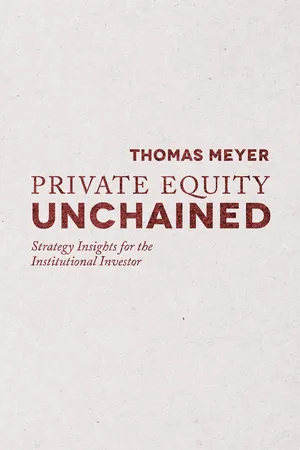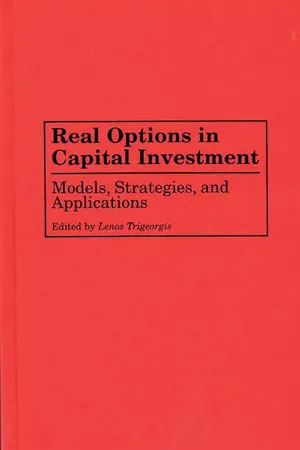Business
Real Options
Real options refer to the strategic opportunities available to a business, allowing it to make decisions based on future uncertainties. These options can include the choice to expand, delay, or abandon a project, and they provide flexibility and value to the business. Real options analysis helps in evaluating and quantifying the potential benefits of these strategic choices.
Written by Perlego with AI-assistance
Related key terms
1 of 5
11 Key excerpts on "Real Options"
- eBook - ePub
Credit Engineering for Bankers
A Practical Guide for Bank Lending
- Morton Glantz, Johnathan Mun(Authors)
- 2010(Publication Date)
- Academic Press(Publisher)
The answer to evaluating such projects lies in Real Options analysis, which can be used in a variety of settings, including pharmaceutical drug development, oil and gas exploration and production, manufacturing, start-up valuation, venture capital investment, information technology infrastructure, research and development, mergers and acquisitions, e-commerce and e-business, intellectual capital development, technology development, facility expansion, business project prioritization, enterprise-wide risk management, business unit capital budgeting, licenses, contracts, intangible asset valuation, and the like. A later section in this chapter illustrates some business cases and how Real Options can assist in identifying and capturing additional strategic value for a firm.The Real Options Solution in a Nutshell
Simply defined, Real Options is a systematic approach and integrated solution using financial theory, economic analysis, management science, decision sciences, statistics, and econometric modeling in applying options theory in valuing real physical assets (as opposed to financial assets) in a dynamic and uncertain business environment where business decisions are flexible in the context of strategic capital investment decision making, valuing investment opportunities, and project capital expenditures.Real Options are crucial in the following situations:- Identifying different corporate investment decision pathways or projects that management can navigate given highly uncertain business conditions.
- Valuing each of the strategic decision pathways and what it represents in terms of financial viability and feasibility.
- Prioritizing these pathways or projects based on a series of qualitative and quantitative metrics.
- Optimizing the value of strategic investment decisions by evaluating different decision paths under certain conditions or using a different sequence of pathways that can lead to the optimal strategy.
- Timing the effective execution of investments and finding the optimal trigger values and cost or revenue drivers.
- Managing existing or developing new optionalities and strategic decision pathways for future opportunities.
Issues to Consider
Strategic options do have significant intrinsic value, but this value is realized only when management decides to execute the strategies. Real Options theory assumes that management is logical and competent and that management acts in the best interests of the company and its shareholders through the maximization of wealth and the minimization of risk of losses. For example, suppose a firm owns the rights to a piece of land that fluctuates dramatically in price. An analyst calculates the volatility of prices and recommends that management retain ownership for a specified time period, where within this period there is a good chance that the price of real estate will triple. Therefore, management owns a call option: an option to wait - Pablo Fernandez(Author)
- 2002(Publication Date)
- Academic Press(Publisher)
There are many types of Real Options: options to exploit mining or oil concessions, options to defer invest-ments, options to expand businesses, options to abandon businesses, options to change the use of certain assets, etc. A real option exists in an investment project when there are future possi-bilities for action when the solution of a current uncertainty is known. Oil concessions are a typical example. The oil well will be operated or not depending on the future price of oil. Designing a new product is also a real option: a W rm has the option of expanding its production facilities or canceling distribution, depending on the market's future growth. Invest-ments in research and development can also be analyzed using options theory. 1 Corporate policy strategists and professors have repeatedly reproached W nanceÐand W nancial analystsÐfor their lack of tools for valuing invest-ment projects' strategic implications . Before using options theory, most new investments were made on the basis solely of qualitative corporate policy criteria. The numbers, if any, were crunched afterward so that they could give the result that the strategist wanted to back his decision. Options theory seems to enable projects' strategic opportunities to be valued: by combining quantitative analysis of the options with qualitative and strategic analysis of the corporate policy, it is possible to make more correct and more rational decisions about the W rm's future. In this chapter, we will study a few simple examples that will enable us to readily see that not considering the options contained in a project may lead us to undervalue it and, in general, turn down projects that we should undertake. 2 We will also analyze a number of Real Options that are present in many investment projects: the option to expand the project, the option to defer the investment, and the option to use the investment for alternative purposes.- eBook - PDF
Strategy, Value and Risk
The Real Options Approach
- J. Rogers(Author)
- 2009(Publication Date)
- Palgrave Macmillan(Publisher)
A large component of the value in applying Real Options lies in the insights gained from the actual process of an analysis. Quantitative models and methods are tools that facilitate the analytical process and provide an abstraction of the problem. They are not black boxes that just produce a number, and are certainly not some enchanted device that provides instant and perfect solutions. Another issue is that while a real option analysis may be theoretically correct, it may not have any significant influence on an organization's management decisions. A Real Options analysis has to consider an organization's culture, decision and management processes. This not only includes how an organization is managed and how decisions are made, but also how on occasions mistakes can be made. Increasing the effectiveness of a Real Options analysis within an organization includes identifying and communicating any limitations, and also seeking any potential interactions with other management disciplines such as industry analysis and competitor analysis. What a Real Options framework does offer is the potential to combine strategic and financial analysis, and integrate investment decisions with corporate strategy and value. Real Options can clarify management decisions by supporting strategic opportunities with values that are aligned with the financial markets, and provide CONCLUSION AND PRACTICAL IMPLICATIONS the means to communicate these values to the financial markets. The Real Options concept also has the potential to enhance the aggregation of an organization's project values and the management of its risk exposures. Real option techniques will become a powerful component of an organization's strategic analysis, valua- tion, decision and risk management processes. - Adedeji B. Badiru(Author)
- 2013(Publication Date)
- CRC Press(Publisher)
An option is a contract that confers its holder the right, without obligation , to acquire or dispose of a risky asset at a set price within a given period. When extended to a real “asset” such as software, Real Options could be used as a decision-making tool in a dynamic and uncertain environment. A central and necessary tenet of the Real Options approach is a 90 80 70 60 50 40 30 20 10 0 % of functions performed in software 8 10 20 80 35 45 65 F - 4 1960 A - 7 1964 F - 111 1970 F - 15 1975 F - 16 1982 B - 2 1990 F/A 22 2000 Weapons systems and year entered service Figure 32.1 Software growth in weapons systems. (From Fields, C., Task Force on Defense Software , Report from the office of the Undersecretary of Defense for Acquisition and Technology, Defense Science Board, Washington, DC, 11–12, 2000.) 701 Chapter thirty-two: Real Options theory for software acquisitions requirement for the presence of uncertainties—an inherent characteristic of most software acquisitions efforts. Real Options are implicit or explicit capabilities created for real assets that provide the option holder with time-deferred and flexible choices (options) regarding future risks or changes of the software and could explicitly address the issue of software investment choices for future capabilities. Through these capabilities, the option holder may choose to adjust, reduce, increase, or abandon the investment in the future, thereby stabilizing returns from these assets. Before its application in any domain, the Real Options approach calls for the existence of five preconditions. These preconditions as outlined in Mun (2006) are as follows: 1. The existence of a basic financial model used to evaluate the costs and benefits of the underlying software asset. 2. The existence of uncertainties during the software acquisition process; otherwise, the Real Options analysis becomes useless as everything is assumed to be certain and known.- eBook - ePub
The Capital Budgeting Decision
Economic Analysis of Investment Projects
- Harold Bierman, Jr., Seymour Smidt(Authors)
- 2012(Publication Date)
- Routledge(Publisher)
Chapter 15An Introduction to Real Options
You make me think of an old Yiddish saying: “It’s good to be open-minded, but if you are too open-minded, your brains fall out.”Deborah Solomon, The New York Times, February 6, 2005A person with an option has a choice. In American football, the quarterback calls an option play and then decides whether to pass or run after the play is in progress. In the stock market, an investor might decide to buy a call option, which gives the right to buy the stock later at a price that is determined now by the terms of the option agreement. In both of these examples, the option gives the decision-maker the right to exercise a choice (run or pass, buy or not buy a stock) at a later time when more information is available and therefore better decisions can be made. An investment project may incorporate options if, after the project is accepted, there are important decisions that can be made that affect the value of the project. In each case, the value of the option derives in part from the fact that delaying the decision provides the decision-maker with more information and therefore the ability to make better decisions.A financial option arises because of an explicit contractual relationship between the owner of the option and another party who is called the writer of the asset. A real option has been defined as “the right, but not the obligation to take an action (e.g., deferring, expanding, contracting, or abandoning) at a predetermined cost, called the exercise price, for a predetermined period of time – the life of the option.”1 If a factory has been designed so that it can be easily expanded, and the owner believes that the cost of such an expansion is predictable, then the factory owner can be said to own an option on the factory expansion. The owner of a call option can acquire an asset in the future at a known cost. The owner of a put option - eBook - ePub
Private Equity Unchained
Strategy Insights for the Institutional Investor
- T. Meyer(Author)
- 2014(Publication Date)
- Palgrave Macmillan(Publisher)
Chapter 22 Real OptionsIn practice, investment decisions in private equity are irreversible in the sense that mistakes cannot be corrected through trading, at least not at an acceptable cost. Consequently, LPs need to be able to select or be in the position to alter their investments in funds postcommitment. Without the ability to respond in a meaningful way to a new development, the situation becomes a bet. This contrasts with ‘Real Options’ that can give investors the ability to respond to insights gained over time as a situation gradually becomes clearer. When primarily relying on selection skills, investors in funds are essentially taking a bet, hoping that calculated risks are taken and assuming the outcome is not dependent on pure chance.Making irreversible ‘all-or-nothing’ decisions in the face of uncertainty is risky, but investors can at least prepare to manage the uncertain outcomes, once they happen. The ‘real option’ methodology recognises the value of deferring investment decisions and of learning over time. It is particularly useful when there is a high degree of uncertainty, some managerial flexibility, and not all the information is known ex ante. Foresight is essentially replaced by quick reaction to new information. Real Options are an important but often overlooked tool for investors. They allow uncertainty to be managed and the impact of positive developments to be amplified.The Value of FlexibilityTraditionally the time value of money of a long-term project is appraised by looking at its Net Present Value (NPV). As this, however, ignores flexibility, Real Options have increasingly become powerful tools for investment strategists. The classical Real Options presented in financial texts are:1 - eBook - ePub
Making the Compelling Business Case
Decision-Making Techniques for Successful Business Growth
- W. Messner(Author)
- 2013(Publication Date)
- Palgrave Macmillan(Publisher)
Investments in strategic options can be beneficial to corporations, allowing a faster reaction at lower cost should the business climate change accordingly. Flexibility can also be viewed as a risk mitigation strategy, which helps the organization to avoid running into deadlocks where it can no longer react to changed market circumstances. However, deciding how much to spend on flexibility options is usually decided by top management via the “rule of thumb”; this kind of capital restriction (see Section 5.4) is obviously very difficult to capture and quantify in a business case. Real Options analysis says that when the future is highly uncertain, it pays to have a broad range of options available. It thus rewards flexibility – and this makes it a superior addition to the standard NPV decision-making tool. While NPV calculates the value of a project by predicting its net cash flows and adjusting them for risk, Real Options analysis boils down all the possibilities for the future into a single scenario and attaches a monetary value to this strategic flexibility. Today’s decision sets the stage for tomorrow’s decision and therefore it must balance: Economy, i.e. the need to reap profit opportunities; with Flexibility, i.e. the capacity to react to future circumstances and needs. 8 Real Options analysis also has its downsides. For one, it is too complex to be worthwhile for minor decisions. Second, it is definitely not useful for projects that require a full investment commitment right at the beginning. The value of a strategic option lies in the ability to spend a little now, establish a strategic platform, and decide later whether to expand based on the earlier investment. 7.2 BLACK–SCHOLES FORMULA In 1697, a Japanese samurai who wanted to control the rice markets established the Do¯jima Rice Exchange in Osaka - eBook - PDF
Real Options in Capital Investment
Models, Strategies, and Applications
- Lenos Trigeorgis(Author)
- 1995(Publication Date)
- Praeger(Publisher)
In the next chapter in this edited volume, Teisberg provides a practical comparative discussion of the DCF, decision analy- sis, and real option valuation paradigms. Baldwin and Clark (1992) have discussed the importance of organizational capabilities in strategic capital investment, while Baldwin and Trigeorgis (1993) proposed remedying the underinvestment problem and restoring competitiveness by developing spe- cific adaptive capabilities to be viewed as an infrastructure for acquiring and managing Real Options. 1.4.2 A New Direction: Conceptual Real Options Approaches Building on Myers's (1977) initial idea of thinking of discretionary invest- ment opportunities as "growth options," Kester (1984) conceptually dis- cussed strategic and competitive aspects of growth opportunities. Other general, conceptual Real Options frameworks are presented in Mason and Merton (1985), Trigeorgis and Mason (1987), Trigeorgis (1988), Brealey and Myers (1991), and Kulatilaka and Marcus (1988, 1992). Mason and Merton (1985), for example, provide a good discussion of many operat- ing, as well as financing, options and integrate them in a project-financing framework for a hypothetical, large-scale energy project. 1.4.3 Generic Medicine: Foundations and Building Blocks The quantitative origins of Real Options, of course, derive from the seminal work of Black and Scholes (1973) and Merton (1973) in pricing financial options. Cox, Ross, and Rubinstein's (1979) binomial approach enabled the development of a more simplified valuation of options in discrete time. Margrabe (1978) valued an option to exchange one risky asset for another, An Overview 19 while Stulz (1982) analyzed options on the maximum (or minimum) of two risky assets and Johnson (1987) extended the analysis to several risky as- sets. - eBook - PDF
Entrepreneurial Finance
Venture Capital, Deal Structure & Valuation, Second Edition
- Janet Kiholm Smith, Richard L. Smith(Authors)
- 2019(Publication Date)
- Stanford Business Books(Publisher)
A re-finer who can switch between producing heat-ing oil and gasoline has the real option to switch outputs. Option to abandon An abandonment option is a right to discontinue an activity and redeploy the real assets to some other use. Abandonment options include the options to dis-continue a research project, close a store, or resign from current employment. 182 Chapter Five It follows that the value of a strategy can be dramatically improved by making good choices about what Real Options to acquire and by using them effectively. The terms of a new-car lease contract, in contrast, do reflect an important financial option premium. When a car is leased, the lessee acquires a financial option. At the end of the lease term, if the market value of the car is high, the lessee can purchase the car by paying a residual value that was negotiated at the time of the original lease transaction. Alternatively, if the market value is low, the lessee can return the car to the lessor so that the lessor bears the downside risk about the future value of the car. Although the underlying asset is real, the car lease contract is a financial option. It is effectively a bet about the future market value of the car, and not an instrument that redeploys the actual (real) use of the asset. 5.8 STRATEGIC PLANNING AND DECISION TREES A decision tree is a useful way to conceptualize strategic alternatives that involve Real Options. Constructing a decision tree imposes discipline on the evaluation process and helps the entrepreneur identify relevant Real Options and the points at which critical decisions must be made. It also enables the entrepreneur to assess, in a structured way, the connections between decisions made today and the value of the venture in the future. Building and Pruning Decision Trees A decision tree incorporates both decisions and uncertain events that affect the value of the outcome. - eBook - ePub
- John Charnes(Author)
- 2012(Publication Date)
- Wiley(Publisher)
CHAPTER 13 Real Options This chapter describes Real Options analysis (ROA), and shows how Crystal Ball and OptQuest can help you determine the value of Real Options. As we have seen, a financial option is the right, but not the obligation, to buy (or sell) an asset at some point within a predetermined period of time for a predetermined price. ROA is used as an alternate methodology for evaluating capital investment decisions involving a high degree of managerial flexibility, such as research and development projects or new product decisions. Unlike the simple net present value (NPV) method used in traditional finance theory, ROA treats an investment opportunity as either a single option or a compound option (a sequence of options). The traditional NPV method does not value managerial flexibility correctly when it relies on the false assumption that an investment is either irreversible or that it cannot be delayed. In this chapter, we will see the similarity between financial and Real Options, then discuss applications of ROA and some analytical methods that have been used with Real Options. The real option valuation (ROV) tool described in the final sections combines the use of Crystal Ball and OptQuest to determine the value of opportunities that contain Real Options. 13.1 FINANCIAL OPTIONS AND Real Options With a financial option, the initial investment in an option contract buys the potential opportunity to enjoy positive cash flow when future spot price changes of the underlying financial asset favor doing so, but does not carry the obligation to realize negative cash flow if unfavorable conditions prevail. For example, the holder of a call option is not obligated to purchase the underlying at the strike price if its spot price is below the strike price on the expiration date, and the holder of a put option is not obligated to sell the underlying at the strike price if the spot price is above the strike price on the expiration date - eBook - PDF
- Dean Paxson(Author)
- 2002(Publication Date)
- Butterworth-Heinemann(Publisher)
186 Real R&D Options criterion, can be substantial in magnitude and highly important in investment appraisal decisions (see Kester, 1984). In the case of traditional financial options, optimal exercise strategies can be derived without consideration of the strategic interactions across option holders. 1 However, this is not the case in Real Options: real investment oppor-tunities are rarely held by one firm in isolation. Most projects or markets are open to more than one firm in the same industry or line of business. In such cases, where investment opportunities are not proprietary to one firm, strategic considerations become important. Optimal (real) option exercise strategies will have to strike a balance between the value of waiting for uncertainty to be resolved and the fear of pre-emption, i.e. the possibility that a rival firm with access to the project/market may seize an advantage by acting first. In this chapter, we provide a game-theoretic approach to Real Options exercise in an effort to highlight the importance of strategic considerations. We focus on the advantage of being first in a market, and our aim is to quantify the effects of such an advantage on investment valuation and exercise policies. We allow the magnitude of first-mover’s advantages or degree of pre-emption to be fully parameterized in the model, which allows us to assess their effect on entry decisions and game equilibria. In our model, two competing firms have the option to enter a market with uncertain profitability. The option to enter is an American-style call option with an exercise price equal to the investment cost, and the underlying security is the (net) profitability derived from operating in the market. However, the exercise of the option to enter by one firm has repercussions on the value of both competing firms’ options. The firm to enter first (the leader) has to sink the investment cost earlier, but can benefit from securing a higher market share than the competitor.
Index pages curate the most relevant extracts from our library of academic textbooks. They’ve been created using an in-house natural language model (NLM), each adding context and meaning to key research topics.










